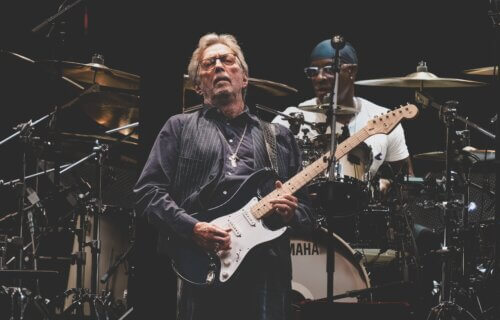Eric Clapton is a legendary English rock and blues guitarist, singer, and songwriter. Widely regarded as one of the most influential guitarists of all time, he has enjoyed a long and successful career spanning over six decades. Clapton played in several bands in the 1960s, including The Yardbirds and John Mayall & the Bluesbreakers, before forming the highly influential supergroup Cream with Jack Bruce and Ginger Baker in 1966. In the late ’60s, he launched a successful solo career after Cream’s disbandment. His music incorporated blues, rock, and pop influences, making some of the best Eric Clapton songs that are listed below.
Do you already have a favorite? With so many incredible tracks in his repertoire, we have researched across eight expert sources to bring you the top seven best Eric Clapton songs of all time. Don’t agree with our list? We would love to hear from you in the comments down below!

The List: Best Eric Clapton Songs, According to Fans
1. “Layla” (1970)

After Cream broke up and his follow-up project, “Blind Faith,” failed after just one record, Clapton was in a fairly bad position. His friend George Harrison was married to the woman he secretly loved, and his drug and alcohol abuse was getting close to a breaking point. According to Ultimate Classic Rock, “Clapton went into the studio and spilled his heart and guts all over the best songs of his career.”
As an epic love song with a beautiful instrumental finale, the album’s centerpiece is undoubtedly one of the most beautiful records ever made. The weeping slide is provided by Duane Allman, while the rest is handled by Clapton, whose guitar playing and voice are at an all-time high. AZ Central says everything about it is undeniable.
In 1992, Clapton took the song back and remade it for his “Unplugged” album and live show. He said the new jazzy rendition was a way to switch it up since he has never considered revamping it. Smooth Radio says that a love story in 7th-century Arabia inspired the song. Who knew?
2. “Cocaine” (1977)
Generally speaking, Clapton’s solo material isn’t nearly as interesting as the songs he recorded with other artists. One of the few exceptions is “Slowhand,” a fantastic solo album including some amazing fretwork and memorable melodies. Ultimate Classic Rock says that it all begins with a cover of “Cocaine,” a song by modern bluesman J.J. Cale.
Of the song, Clapton himself said that writing a purposefully anti-drug song and hoping it becomes popular is not a good idea. Smooth Radio says he continues with, “so the best thing to do is offer something that seems ambiguous.”
Whether heard as a warning song or hailed as a rock classic, “Cocaine” will always have a particular place in Eric Clapton’s history since it captures the essence of rock ‘n’ roll rebellion and displays his unmatched skill as a performer and musician. Singers Room calls it a cultural touchstone.
3. “I Shot The Sheriff” (1974)
When Clapton recorded a rendition of Bob Marley’s original “I Shot the Sheriff” for his second solo album in 1974, the song had only been around for a year. Though more relaxed funk than reggae, Clapton’s only number one single fits the beat, riding a carefree vocal wave that sometimes recalls Marley’s lilting drawl. “The song itself takes precedent over guitar heroics this time,” according to Ultimate Classic Rock.
While most Americans were unaware of Bob Marley, this song introduced reggae to the mainstream in the United States by peaking at number one on Billboard’s Hot 100. This was the 1970s, a time when a pop single written from the point of view of a man who openly admits to shooting the sheriff would not have scared as many people. AZ Central says Clapton represents it in a conversational manner.
The narrative of the song is that of a man who kills the dishonest local sheriff and is mistakenly accused of killing the deputy. According to Smooth Radio, it was only a year later that “Eric released a rock-tinged cover version, and it became an even bigger hit than the original.”
4. “Crossroads” (1988)
The definitive version of Clapton’s rendition of the iconic bluesman Robert Johnson’s “Crossroads” can be found on Cream’s “Wheels of Fire” album’s live half. In fact, he titled his outstanding 1988 career-spanning box set after the song. Ultimate Classic Rock makes the analogy that it’s short, fat-free, and a potent illustration of Clapton’s enduring commitment to the blues.
Since its release, “Crossroads” has established itself as a mainstay in Clapton’s live sets, demonstrating his extraordinary guitar prowess and bearing witness to his ongoing impact on the rock music industry. Its everlasting appeal and legendary status have cemented its standing as one of Clapton’s best creations and a mainstay of the blues-rock genre. According to Singers Room it lyrically “explores themes of temptation, redemption, and the eternal struggle between good and evil.”
“Crossroads” has become a mainstay on classic rock radio. Over the previous forty years, Clapton has performed it at the majority of his solo gigs as well, but it has never sounded nearly as sublime as it did with Cream. Rolling Stone says, “To many Clapton fans, this song represents Clapton’s playing at its absolute peak.”
5. “Tears in Heaven” (1991)
This song, which Eric co-wrote for the 1991 film “Rush,” was also influenced by the untimely passing of his young son Conor. His mother’s friend occupied a 53rd-floor apartment in New York, where his four-year-old kid fell from a window. Shortly after, Clapton reached the site. Smooth Radio informs us that he stopped performing the song in 2004 because he was no longer in that tragic place, and didn’t want to re-live those feelings.
Aside from its personal meaning, “Tears in Heaven” resonates with everyone who has ever felt the anguish of losing a loved one. Beyond boundaries, the song’s universal message of love and sorrow provides solace and healing to people who bear their own personal burdens of bereavement. The song has become synonymous with Clapton’s legacy, according to Singers Room.
It’s a blues song even if it lacks Clapton’s trademark guitar because each time we hear it, we can feel his suffering. It’s the pinnacle of his songwriter career. WRIF says Clapton fans were shocked when they first heard the gentle tune.
6. “Wonderful Tonight” (1977)

Eric Clapton wrote this song for his then-girlfriend Pattie Boyd, who divorced pal George Harrison the same year. It was included on his 1977 album “Slowhand.” He wrote it while waiting for her to get ready for the yearly Buddy Holly celebration hosted by Paul and Linda McCartney. Smooth Radio says they were married two years later but divorced in 1989.
Eric Clapton’s “Wonderful Tonight” is a timeless and captivating tune. The song has since grown to be regarded as a timeless classic due to its poignant words and lovely melody. Singers Room says it “exudes a sense of intimacy and romance that resonates with listeners of all ages.”
The song is a popular option for weddings and romantic gatherings worldwide because of its straightforward yet moving lyrics, which convey the beauty of a tender moment shared between lovers. Singers Room stands as “one of Eric Clapton’s most enchanting and enduring ballads.”
7. “Bell Bottom Blues” (1973)
“Bell Bottom Blues” is a song that was made during Clapton’s time with Derek & The Dominos. It isn’t as grandiose as some of the band’s other songs because Duane Allman wasn’t with Derek and the Dominos when the song was recorded. However, Clapton compensates for Allman’s absence with a solo that is among his most expressive. Ultimate Classic Rock says that on the song as well as the entire album, he has excellent vocals.
The intensity that Clapton puts into the singing makes it one of the most devastating ballads in rock history, and he somehow reflects that feeling in one of the most brilliant solos he’s ever played. AZ Central informs us that “it peaked at No. 91 on Billboard’s Hot 100 when originally issued but climbed higher when reissued two years later.”
Clapton shared that Pattie Boyd asked him to get her some pairs of these jeans they used to call Landlubbers. She wanted them flare and they had two little pockets in the front, according to Rolling Stone.
Sources:
- AZ Central
- Ultimate Classic Rock
- Smooth Radio
- Gold Radio
- Rolling Stone
- Ranker
- uDiscover Music
- DJ Mike
Note: This article was not paid for nor sponsored. StudyFinds is not connected to nor partnered with any of the brands mentioned and receives no compensation for its recommendations. This article may contain affiliate links in which we receive a commission if you make a purchase.
